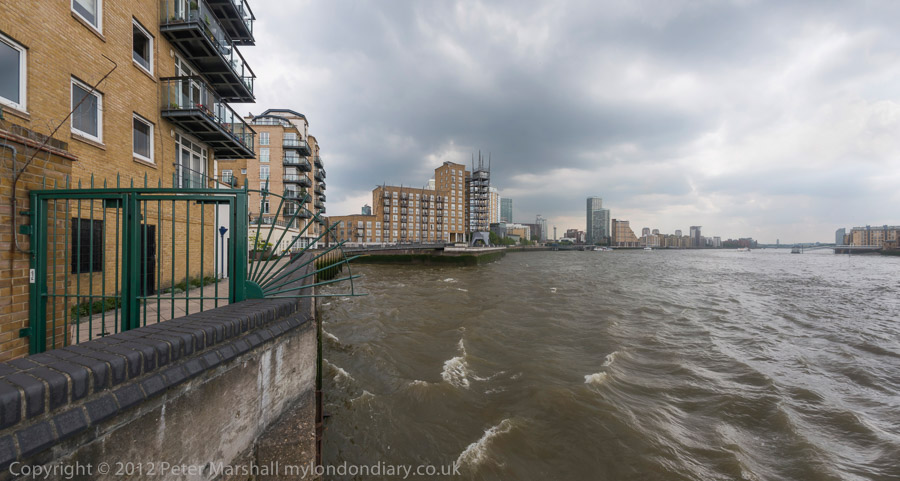
The Thames path goes through a gate open during daylight hours D800E, 16mm
I bought my first proper panoramic camera towards the end of 1991, having lusted after one for some years. I’d thought about the possibilities on offer – not all that many – but it was mainly cost which had stopped me getting one before. I’d played with panoramas a bit, taking multiple images, had used cheap single-use cameras that called itself panoramic and had investigated masking down wide-angle images taken on Kodak Ektar 25, but all these were a pain and not really satisfactory.
The single use camera did give images in a panoramic format, but didn’t have a very wide angle of view – perhaps around that of a 28mm lens. With a cheap lens and using fast colour negative film, the images were OK at the 4×10″ they were designed for, but decidedly soft and grainy when I took them up a little in size. Fixed focus meant they were not sharp at infinity, and a lack of aperture and shutter control limited use to bright sunny days.
Masking down the 35mm Extar X negatives taken in a normal camera to around 36x15mm certainly gave better technical quality (even better than Kodachrome 25), but was still limited in its field of view by the lenses I owned, the widest of which was a 21mm f3.5 Zuiko which fitted my Olympus OM4 bodies. There were wider lenses available – including a 16mm f3.5 full frame fisheye, but I didn’t own one and there was no simple way to correct the curvature that this produced. The 90 degree field of view of the 21mm still didn’t seem quite enough to me.
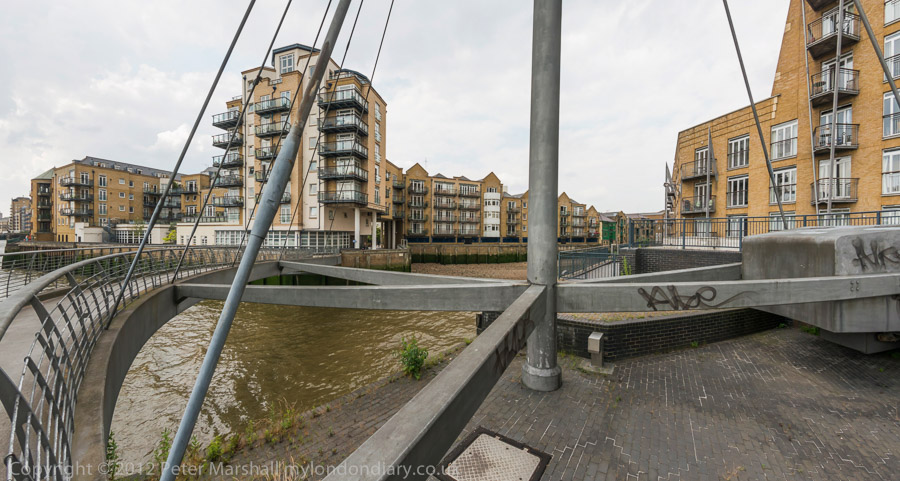
The bridge for the Thames path across Limekiln Dock D800E, 16mm
I wanted a camera that was portable, gave a decent negative size and I could afford. I had no desire to make huge prints, and hated processing 120 film, so those producing longer than usual negatives on 35mm looked good. But the prices didn’t. Eventually I saved around a month’s salary and bought a Japanese Widelux F8, and began my real work with panoramic images. Later I replaced this by a cheaper Russian Horizon camera, which apart from a better range of shutter speeds also had a viewfinder (the Widelux just had arrows on top to indicate the angle of view) which incorporated a spirit level, making hand-held use for landscapes a possibility. And later still came the Hasselblad XPan, which, at least with a 30mm lens, gave rectilinear panoramas at around the sensible limit of angle of view.
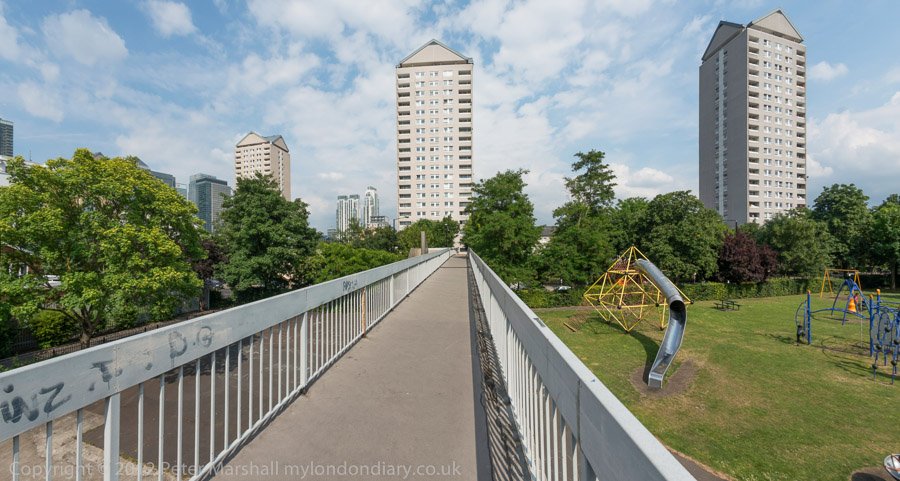
This bridge was built to connect the council estate to a riverside park across a road then busy with docks traffic D800E, 16mm
When I took up digital photography serious with a Nikon D100 in 2002, it became possible to stitch together images digitally to make panoramas. But it was still much easier to take them on film, with a single press of the shutter release, especially when there were moving objects in the frame. So ten years after going digital, I was still – at least theoretically – using film for panoramas. Except that I wasn’t. Film had become just too much of a hassle. I was simply taking fewer panoramas – and making those from multiple digital images.
It was the high quality 32Mp files of the D800E that made me rethink and go back to making panoramic images from a single exposure. Using the Nikon 16mm full-frame fisheye I can digitally process the images and end up with panoramas 9706 pixels wide and a 146 degree horizontal angle of view. The full vertical angle is actually larger than I want, and I crop the images down, usually to around a 1.9: 1 aspect ratio, which gives a little freedom about where to place the horizon – the digital equivalent of a rising/falling front. The D800E also has built-in level indicators in the viewfinder, which are vital.
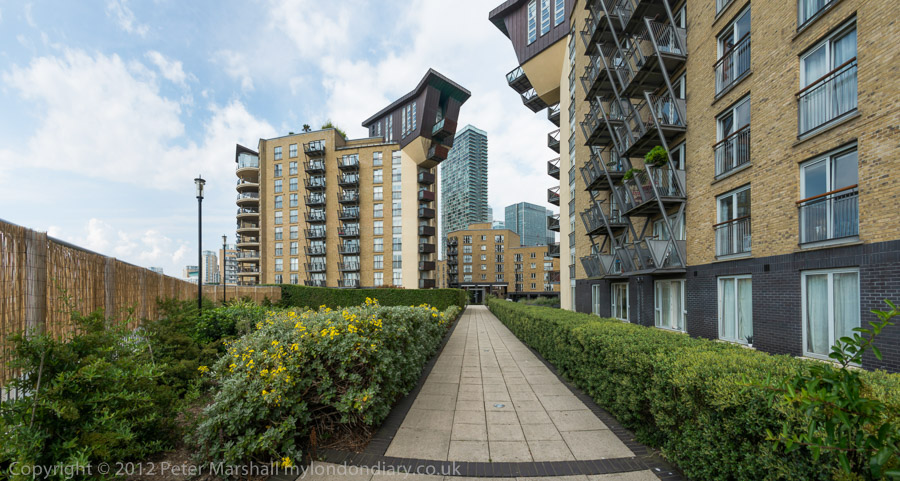
Riverside flats D800E, 16mm
Now my main limiting factor in making panoramic images is simply time to do so, with so many other things to photograph – as well as writing about it. And also the weather, as clear blue or evenly grey skies can ruin many pictures. Not to mention my legs, which no longer take long walks and standing around to make pictures without complaint.
Also important is the time spent in post-processing, which is considerably longer than for straightforward images. Adding a minute or two for each image would perhaps not be too vital, but where you can directly assess a normal image with a glance at the preview, for these panoramas you really have to process them to the end result before you can be sure if they work. Processing these images from a single afternoon held up my updating of My London Diary for some days.
Over the years I’ve watched – and occasionally photographed – as the Thames in London has turned from the post-industrial landscape that features in my London’s Industrial Heritage into living space for the rich, with blocks of luxury flats now lining most of its banks. In the process the river has lost much but not all of its fascination, and the rest of us have gained much greater access to a riverside that now has much less worth seeing.
The weather for my walk was London’s best – highly changeable. Spells of light rain, impressive clouds, grey skies and blue skies. Even on digital – usually far truer to life than film – it often looked too extreme, and I had to lighten some of the dark clouds. With open views like most of these you do get a lot of weather.
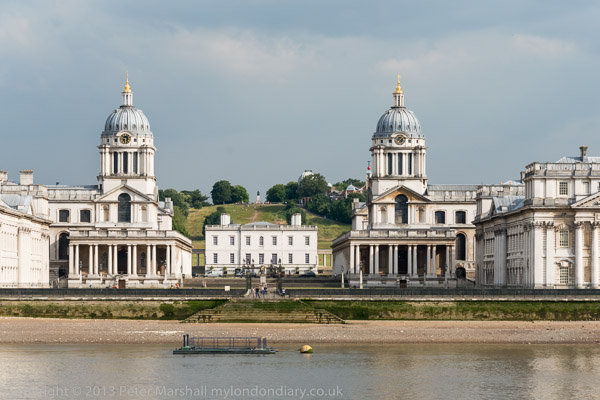
The view from Island Gardens D800E 80mm on 18-105mm
I’ve divided the pictures from the walk into two sections, largely for convenience of reference, with pictures from Limehouse and then from Millwall – Isle of Dogs. At the end of the walk – a pleasant mainly riverside stroll of perhaps 6km which took me two and a half hours with a camera but would have been half that without – I also took a few other pictures of Greenwich from the Isle of Dogs. Arguably the view from Island Gardens is one of London’s finest, and at that time of day is at its best.
______________________________________________________
My London Diary : Buildings of London : River Lea/Lee Valley : London’s Industrial Heritage
All photographs on this and my other sites, unless otherwise stated, are taken by and copyright of Peter Marshall, and are available for reproduction or can be bought as prints.
To order prints or reproduce images
________________________________________________________